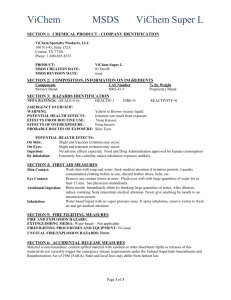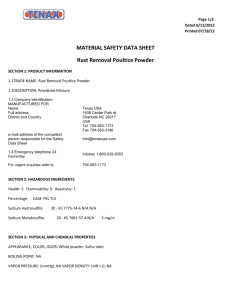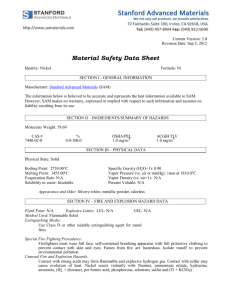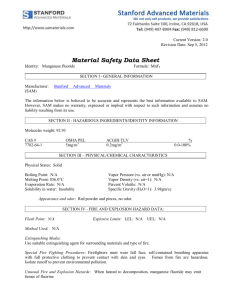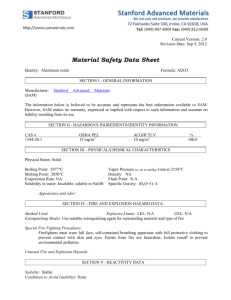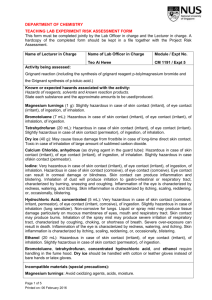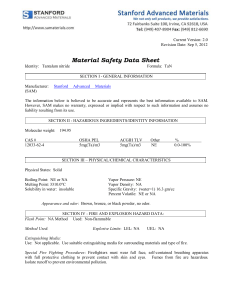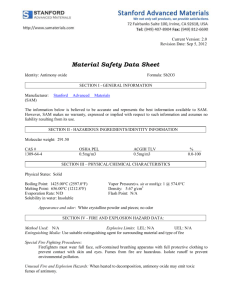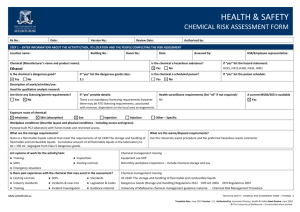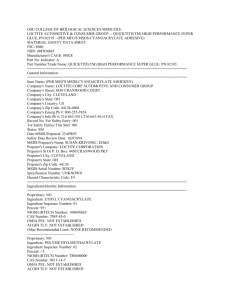End Of MSDS
advertisement
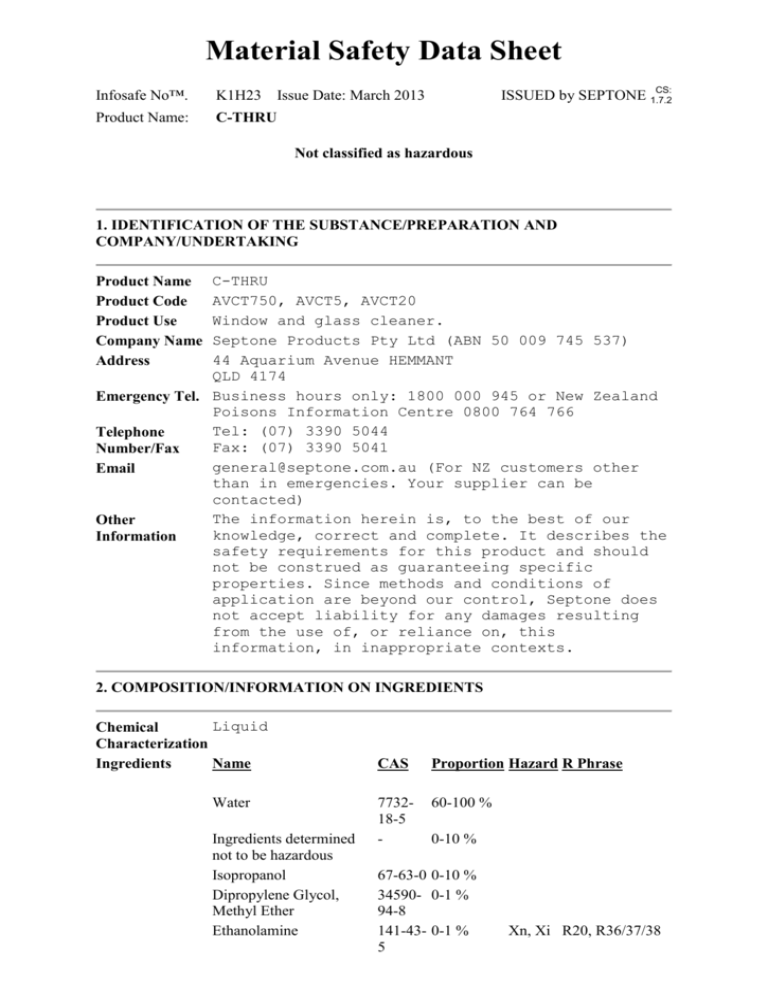
Material Safety Data Sheet Infosafe No™. K1H23 Product Name: C-THRU CS: ISSUED by SEPTONE 1.7.2 Issue Date: March 2013 Not classified as hazardous 1. IDENTIFICATION OF THE SUBSTANCE/PREPARATION AND COMPANY/UNDERTAKING C-THRU AVCT750, AVCT5, AVCT20 Window and glass cleaner. Septone Products Pty Ltd (ABN 50 009 745 537) 44 Aquarium Avenue HEMMANT QLD 4174 Emergency Tel. Business hours only: 1800 000 945 or New Zealand Poisons Information Centre 0800 764 766 Tel: (07) 3390 5044 Telephone Fax: (07) 3390 5041 Number/Fax general@septone.com.au (For NZ customers other Email than in emergencies. Your supplier can be contacted) The information herein is, to the best of our Other knowledge, correct and complete. It describes the Information safety requirements for this product and should not be construed as guaranteeing specific properties. Since methods and conditions of application are beyond our control, Septone does not accept liability for any damages resulting from the use of, or reliance on, this information, in inappropriate contexts. Product Name Product Code Product Use Company Name Address 2. COMPOSITION/INFORMATION ON INGREDIENTS Liquid Chemical Characterization Ingredients Name Water Ingredients determined not to be hazardous Isopropanol Dipropylene Glycol, Methyl Ether Ethanolamine CAS Proportion Hazard R Phrase 773218-5 - 60-100 % 0-10 % 67-63-0 0-10 % 34590- 0-1 % 94-8 141-43- 0-1 % 5 Xn, Xi R20, R36/37/38 3. HAZARDS IDENTIFICATION Sensitization of None of the components of this product is considered to be a skin or respiratory Product sensitiser. Teratogenicity None of the components of this product is considered to be a teratogen. None of the components of this product is Reproductive considered to be toxic to the unborn foetus. Toxicity None of the components of this product is Mutagenicity considered to be a mutagen. Carcinogenicity None of the components of this product is considered to be a carcinogen. Chronic Effects Prolonged or chronic inhalation of isopropyl alcohol may cause headaches and central nervous system depression. Prolonged and constant skin contact may lead to dermatitis. Chronic ingestion may result in liver damage and can lead to alcoholism. Excessive inhalation of spray mists may result in Inhalation respiratory tract irritation. Prolonged or chronic exposure may cause headaches and central nervous system depression. Irritant. Ingestion of large amounts may cause Ingestion headache, dizziness, dullness, gastric disorders and central nervous system depression. Irritant. May cause dermatitis after prolonged Skin and constant use. Mild eye irritant. Eye 4. FIRST AID MEASURES Remove the victim from the source of exposure. If the victim is not breathing, apply artificial resuscitation. Do NOT induce vomiting. Give water to drink. Seek Ingestion medical attention. Remove contaminated clothing and launder before Skin re-use. Wash affected skin with water. Hold the eyes open and flush with water for at Eye least 15 minutes. Seek medical attention. Eye wash station. This Material Safety Data Sheet First Aid should be provided to the attending medical Facilities doctor. Advice to Doctor Treat symptomatically. Inhalation 5. FIRE FIGHTING MEASURES Extinguishing Media Use the extinguisher appropriate to the source of the fire or to the principal fire hazard. Specific Hazards None known. This product is not flammable under the conditions of use and does not support combustion. If this product is involved in a fire, Protective firefighters should wear full protective clothing Equipment including self-contained breathing apparatus. This product will not flash. Flash Point This product is not classified as a flammable Flammability liquid. 6. ACCIDENTAL RELEASE MEASURES Spills & Disposal Personnel involved in cleaning up any spills are to wear gloves and goggles. If there is the possibility of a fire, then personnel should also wear self-contained breathing apparatus. Cordon off the spillage area. Isolate the source of the spillage or leak. Contain the spillage using a suitable non-flammable absorbent material such as sand or diatomaceous earth, and then transfer into sealed plastic containers for disposal. 7. HANDLING AND STORAGE Store in plastic containers in a clean, dry, cool, well ventilated place away from foodstuffs. Keep containers sealed when not in use. 8. EXPOSURE CONTROLS/PERSONAL PROTECTION National Exposure Standards Name mg/m3 ppm (STEL) (STEL) mg/m3 ppm TWA (TWA) (TWA) Footnote Water Ingredients determined not to be hazardous Isopropanol 1230 500 983 400 Dipropylene Glycol, 308 50 'skin' Methyl Ether Ethanolamine 15 6 7.5 3 Other Exposure A 'skin' notation means that the substance may also be readily absorbed through the skin, which Information may be through direct contact or from exposure to very high atmospheric concentrations of vapour. The TLV is obviously invalidated if such contact should occur. Not required under normal conditions of use. Wear Personal gloves and chemical goggles if handling large Protective amounts and if splashing is likely to occur. Wear Equipment an organic vapour respirator if insufficent engineering controls exist to maintain operator exposure below the exposure limits quoted. Eng. Controls Natural ventilation adequate under normal conditions of use. If using the product in a spray mist form, the ventilation must be capable of limiting exposure to below the exposure standards quoted. Keep containers closed when not in use. 9. PHYSICAL AND CHEMICAL PROPERTIES Appearance Boiling Point Solubility in Water Specific Gravity (H2O=1) pH Value Evaporation Rate Volatile Component Flash Point Flammability Clear pale blue mobile liquid, alcoholic odour. 82 - 187°C Complete 0.980 @ 25°C 10.5 Slightly faster than the evaporation rate for Water > 99% v/v This product will not flash. This product is not classified as a flammable liquid. 10. STABILITY AND REACTIVITY Stability Hazardous Polymerization Materials to Avoid Hazardous Decomposition Products Conditions to Avoid Considered stable to heat and light. Store below 30°C. Keep out of direct sunlight. Will not occur. Strong oxidising agents. Upon heating or if this product is involved in a fire, the water and isopropanol contained in the product may evaporate, leaving a combustible residue behind. During combustion, this residue may produce carbon monoxide as well as other unidentifiable organic compounds. None known. 11. TOXICOLOGICAL INFORMATION Inhalation Ingestion Excessive inhalation of spray mists may result in respiratory tract irritation. Prolonged or chronic exposure may cause headaches and central nervous system depression. Irritant. Ingestion of large amounts may cause headache, dizziness, dullness, gastric disorders and central nervous system depression. Irritant. May cause dermatitis after prolonged and constant use. Mild eye irritant. Eye Chronic Effects Prolonged or chronic inhalation of isopropyl alcohol may cause headaches and central nervous system depression. Prolonged and constant skin contact may lead to dermatitis. Chronic ingestion may result in liver damage and can lead to alcoholism. None of the components of this product is Reproductive considered to be toxic to the unborn foetus. Toxicity None of the components of this product is Mutagenicity considered to be a mutagen. Carcinogenicity None of the components of this product is considered to be a carcinogen. Skin 12. ECOLOGICAL INFORMATION Short Summary of Assessment of Environmental Impact At normal use levels and following standard effluent treatment, this product is expected to exhibit low toxicity towards aquatic organisms. However, the undiluted material should be prevented from entering waterways. The volatile components of this product are readily biodegradable. The surfactants used in this product are ultimately biodegradable. None of the components of this product are expected to bioccumulate. 13. DISPOSAL CONSIDERATIONS Product Disposal Container Disposal Dispose of large amounts in a chemical dump according to local authority statutory requirements. For small amounts, wash the product to the drain with a large excess of water. Empty containers may be recycled. 14. TRANSPORT INFORMATION IMO Marine Pollutant This product is classified as non dangerous according to the ACTDG. To the manufacturer's best knowledge, none of the components of this product is classified by the IMO to be a Marine Pollutant. 15. REGULATORY INFORMATION Poisons Schedule Not Scheduled AICS (Australia) To the manufacturer's best knowledge, all of the components of this product are listed on AICS (Australian Inventory of Chemical Substances). 16. OTHER INFORMATION Contact Person/Point Poisons Schedule Technical Manager (07) 3390 5044 Not Scheduled ...End Of MSDS... (C) Copyright ACOHS Pty Ltd Copyright in the source code of the HTML, PDF, XML, XFO and any other electronic files rendered by an Infosafe system for Infosafe MSDS displayed is the intellectual property of Acohs Pty Ltd. Copyright in the layout, presentation and appearance of each Infosafe MSDS displayed is the intellectual property of Acohs Pty Ltd. The compilation of MSDS's displayed is the intellectual property of Acohs Pty Ltd. Copying of any MSDS displayed is permitted for personal use only and otherwise is not permitted. In particular the MSDS's displayed cannot be copied for the purpose of sale or licence or for inclusion as part of a collection of MSDS without the express written consent of Acohs Pty Ltd.
